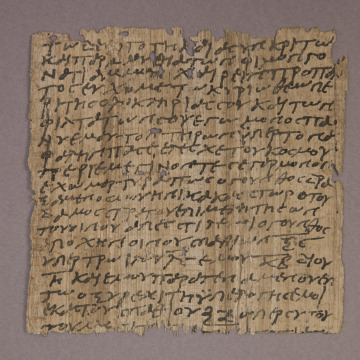Papyrus Fragment
- Artist Culture
- Egyptian
- Period
- Roman period, 30 BC–AD 395
- Date
- 4th century
- Material
- Ink on papyrus
- from
- Oxyrhynchus, Al Minya governorate, Egypt, Africa
- Classification
- Books & manuscripts
- Current Location
- Not on view
- Dimensions
- 4 3/8 x 4 1/2 in. (11.1 x 11.4 cm)
- Credit Line
- Museum Purchase
- Rights
- Contact Us
- Object Number
- 371:1923
NOTES
This papyrus fragment comes from the site of Oxyrhynchus in central Egypt, where, during the late 19th and early 20th century, thousands of documents dating from the 1st–6th centuries AD were discovered. This document preserves a portion of a letter written by Ammon to his friend Gonatas, complaining of the treatment he received while buying some wine, and inviting sympathy or assistance.
Papyrus (Cyperus papyrus) is an aquatic reed native to Africa that once grew in abundance along the banks of the Nile River. As early as the 4th millennium BC, the Egyptians learned how to process the reedy stems of the papyrus plant into a type of proto-paper. Papyrus was also used to make other things like mats, rope, baskets, and even sandals.
Provenance
1893 - 1908
Excavated by B. P. Grenfell (1869-1926) and A. S. Hunt (1871-1934), Oxyrhynchus, Egypt, under the administration of the Egyptian Exploration Society, Graeco-Roman Branch [1]
1893 - 1922
Egyptian Exploration Society, London, England [2]
1922 -
Saint Louis Art Museum, purchased from the Egyptian Exploration Society [3]
Notes:
[1] The excavation of the Oxyrhynchus Papyri, one of the most important archaeological and philological discoveries of the 20th century, was conducted by Grenfell and Hunt under the administration of the Egyptian Exploration Society (EES) during the years 1893 to 1908. In 1897, a special department of the EES was created, called the Graeco-Roman Branch, for the discovery and publication of remains of classical antiquity and early Christianity in Egypt. The publication of the Oxyrhynchus Papyri was conducted by this branch, under the series title of "Graeco-Roman Memoirs." [Grenfell and Hunt, "The Oxyrhynchus Papyri, Vol. 15, London: Egyptian Exploration Society, 1922], ["The Graeco-Roman Branch," Egypt Exploration Society, accessed July 25, 2007,].
[2] The EES was in possession of this selection of the Oxyrhynchus Papyri (368-377:1923) from their excavation until 1922. This group was originally apportioned to Washington University in St. Louis along with a larger selection of papyri, but relegated to the City Art Museum. See letter from Samuel L. Sherer, Esq., Director of the City Art Museum of Saint Louis to Miss Marie N. Buckman, Secretary of the Egyptian Exploration Society, dated June 27, 1922 [SLAM document files].
[3] See note [2]. Minutes of the Administrative Board of Control of the City Art Museum, June 21, 1922 [SLAM document files].
Excavated by B. P. Grenfell (1869-1926) and A. S. Hunt (1871-1934), Oxyrhynchus, Egypt, under the administration of the Egyptian Exploration Society, Graeco-Roman Branch [1]
1893 - 1922
Egyptian Exploration Society, London, England [2]
1922 -
Saint Louis Art Museum, purchased from the Egyptian Exploration Society [3]
Notes:
[1] The excavation of the Oxyrhynchus Papyri, one of the most important archaeological and philological discoveries of the 20th century, was conducted by Grenfell and Hunt under the administration of the Egyptian Exploration Society (EES) during the years 1893 to 1908. In 1897, a special department of the EES was created, called the Graeco-Roman Branch, for the discovery and publication of remains of classical antiquity and early Christianity in Egypt. The publication of the Oxyrhynchus Papyri was conducted by this branch, under the series title of "Graeco-Roman Memoirs." [Grenfell and Hunt, "The Oxyrhynchus Papyri, Vol. 15, London: Egyptian Exploration Society, 1922], ["The Graeco-Roman Branch," Egypt Exploration Society, accessed July 25, 2007,
[2] The EES was in possession of this selection of the Oxyrhynchus Papyri (368-377:1923) from their excavation until 1922. This group was originally apportioned to Washington University in St. Louis along with a larger selection of papyri, but relegated to the City Art Museum. See letter from Samuel L. Sherer, Esq., Director of the City Art Museum of Saint Louis to Miss Marie N. Buckman, Secretary of the Egyptian Exploration Society, dated June 27, 1922 [SLAM document files].
[3] See note [2]. Minutes of the Administrative Board of Control of the City Art Museum, June 21, 1922 [SLAM document files].

